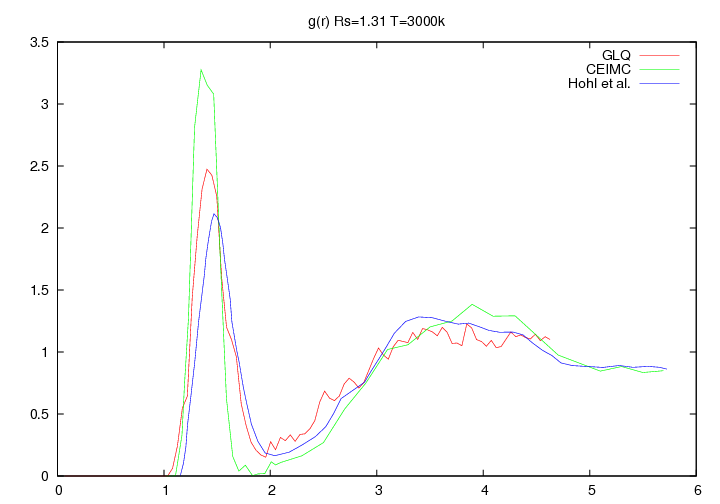



Next: Another possible phase in
Up: Preliminary results on high
Previous: Comparison with previous calculations
Contents
In this section we report the proton-proton pair correlation functions for different densities and temperatures obtained by using the GLQ technique. The pair correlation function is defined (see Allen Tildesley (98)) as:
 |
(6.1) |
Figure 6.3:
Proton-proton correlation function, g(r), at Rs=1.31. The GLQ and CEIMC have used a periodical simulation box with 32 atoms while Hohl et al. with 64 atoms. All the calculations were performed for a single  point (
point ( ).
).
|
|
The pair distribution function is a useful property because it provides insights for the liquid or solid structure.
We compared the obtained proton-proton distribution functions with the ones reported in Ref. (99,7) for different densities .
Figure:
Comparison of the proton-proton correlation function, g(r), at Rs=2.1 and T=4350 obtained with different methods CEIMC (8) (7) and GLQ. All the simulations were performed with 32 atoms for a single  point (
point ( ).
).
|
|
Hohl et al. (1993) have performed DFT-LDA simulations at rs = 1.78 and T=3000K, the resulting proton-proton distribution functions are compared in 6.3.
The lack of accuracy of Local Density Approximation (LDA), used by Hohl et. al, and the small size, we simulated, can account for the differences in the location of the peak.
The discrepancy between CEIMC and GLQ is not clear at present. It can be explained by the nature of the wave-function used in CEICM that does not describe well the molecular disassociation (7). Nevertheless at density  the inter-atomic distances are comparable with the typical bonding length of the hydrogen molecule and we have found a tendency to filament formation in agreement with the results of Hohl and Ceperly (99).
the inter-atomic distances are comparable with the typical bonding length of the hydrogen molecule and we have found a tendency to filament formation in agreement with the results of Hohl and Ceperly (99).




Next: Another possible phase in
Up: Preliminary results on high
Previous: Comparison with previous calculations
Contents
Claudio Attaccalite
2005-11-07



